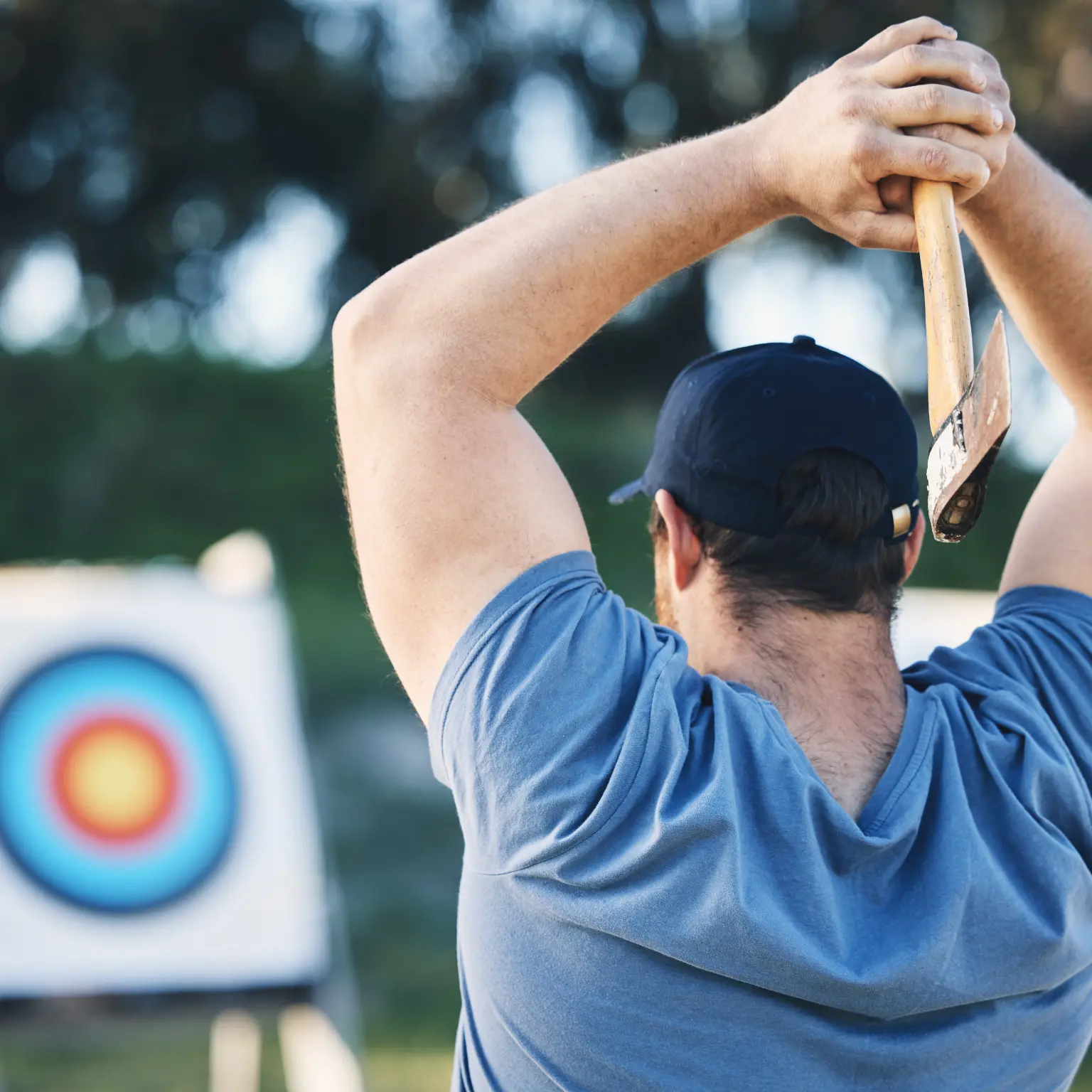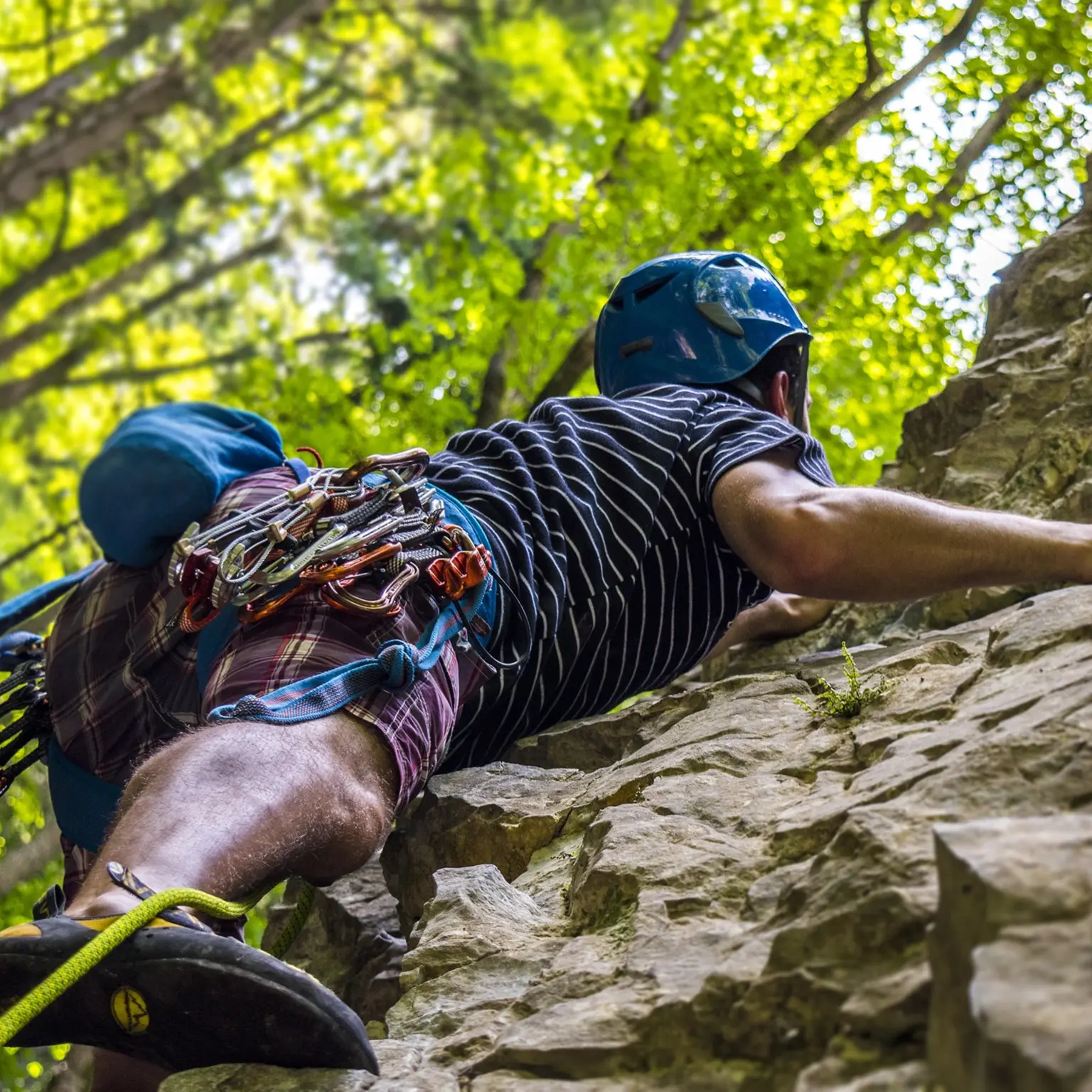How to Improve Your Axe Throwing Skills Fast?

Welcome to Healthy Stride Wellness! We’ve brought you this amazing blog to help you master the art of outdoor axe throwing. Whether you’re a beginner or looking to refine your skills, this guide will provide actionable tips and strategies to improve your axe throwing abilities fast.
Table of Contents
Key Takeaways
- Master the Basics: Focus on grip, stance, and release techniques to build a solid foundation.
- Practice with Purpose: Incorporate specific drills and consistency in your practice routine.
- Mindset and Focus: Cultivate a focused and positive attitude to improve accuracy and confidence.
Understanding the Basics of Outdoor Axe Throwing
What is outdoor axe throwing?
Outdoor axe throwing is a thrilling sport that combines precision, strength, and skill. Originating as a survival skill in ancient times, axe throwing has evolved into a popular recreational activity, particularly in developing countries where people seek new and exciting ways to enjoy the outdoors. Whether you’re competing in a league or simply enjoying a weekend activity, the appeal lies in the challenge of consistently hitting a target with a heavy, sharp tool.
Importance of mastering the fundamentals
- Before diving into advanced techniques, it’s crucial to understand and master the basics of outdoor axe throwing.
- These foundational skills are the building blocks of consistent and accurate throws.
- By focusing on grip, stance, and release, you’ll develop the muscle memory and control necessary to excel in this sport.
- Starting with the basics also reduces the risk of injury and ensures that you can safely enjoy the activity.
Selecting the Right Axe for Outdoor Throwing
Types of axes suitable for outdoor throwing
Choosing the right axe is one of the most critical factors in improving your outdoor axe throwing skills. There are various types of axes designed for throwing, each with unique characteristics. Common options include:
- Hatchets: Small, lightweight, and ideal for beginners.
- Tomahawks: Slightly larger than hatchets, tomahawks offer a good balance between weight and control.
- Competition Axes: These are heavier and designed for more advanced throwers who participate in leagues and competitions.
Weight, balance, and handle considerations
When selecting an axe, pay close attention to its weight, balance, and handle design. A well-balanced axe will have its weight evenly distributed, making it easier to control during the throw. The handle should feel comfortable in your hand, with a length that suits your throwing style and physical build. Beginners should opt for lighter axes to focus on form, while more experienced throwers might prefer a heavier axe for added power.
How to choose the best axe for your skill level?
Your choice of axe should match your current skill level. If you’re just starting, a lightweight hatchet with a shorter handle can help you focus on accuracy and form. As you progress, you might consider moving to a tomahawk or a competition axe, which offers more versatility and power. Always try out different axes to see which one feels the most natural and comfortable in your hand.
The Proper Grip: Holding Your Axe Correctly
Understanding the importance of grip
The way you grip your axe significantly impacts the accuracy and power of your throw. A proper grip ensures that you maintain control throughout the throw and that the axe rotates correctly toward the target. An improper grip can lead to inconsistent throws and missed targets, making it a crucial aspect to master early on.
Step-by-step guide to achieving the perfect grip
- Start with a relaxed hand: Hold the axe with your dominant hand, ensuring that your hand is relaxed and not tense. A relaxed grip allows for smoother release and better control.
- Position your hand on the handle: Place your hand just below the axe head, with your thumb wrapped around the handle. Your fingers should naturally curl around the handle, creating a secure but not overly tight grip.
- Align your knuckles: Make sure your knuckles are in line with the axe blade. This alignment helps in maintaining a straight trajectory as you throw.
- Check your wrist: Keep your wrist straight and firm. Avoid bending it, as this can affect the rotation and direction of the axe.
Common grip mistakes and how to avoid them?
One common mistake is gripping the axe too tightly, which can lead to wrist strain and hinder a smooth release. Another mistake is placing your hand too low on the handle, which reduces control and accuracy. To avoid these issues, practice holding the axe with a relaxed but firm grip, focusing on proper hand placement and alignment.
Perfecting Your Stance for Maximum Accuracy
The role of stance in outdoor axe throwing
Your stance is a fundamental aspect of outdoor axe throwing, as it provides the stability and balance needed for an accurate throw. A solid stance ensures that your body is aligned with the target and helps you generate the right amount of power while maintaining control. Without a proper stance, even the most skillful throws can become inconsistent.
How to position your feet and body for stability?
- Feet placement: Stand with your feet shoulder-width apart, providing a stable base. Your dominant foot should be slightly behind the other foot, pointing towards the target. This staggered stance allows you to shift your weight naturally during the throw.
- Upper body alignment: Your shoulders should be square to the target, and your head should remain steady, with your eyes focused on where you want the axe to land. Avoid leaning too far forward or backward, as this can disrupt your balance and throw off your aim.
- Weight distribution: Distribute your weight evenly between both feet. As you prepare to throw, shift your weight slightly onto your back foot, and then transfer it smoothly to your front foot during the throw. This shift in weight helps generate power and maintains control.
3 Tips for maintaining balance during the throw
- Stay centered: Keep your body centered throughout the throw. Avoid excessive movement or swaying, which can throw off your balance and accuracy.
- Use your core: Engage your core muscles to stabilize your body and ensure a smooth, controlled motion. A strong core helps prevent unnecessary movements and improves overall accuracy.
- Practice consistency: Repetition is key to developing a consistent stance. Practice maintaining the same stance with each throw to build muscle memory, leading to more accurate and reliable results.
The Art of the Throw: Mastering Release Techniques
The mechanics of a successful axe throw
Mastering the release is crucial to successful axe throwing. The goal is to release the axe at the right moment, ensuring it rotates once before hitting the target, especially if you are aiming for the bullseye from the standard distance. The key is to combine a smooth, controlled motion with precise timing.
Different throwing techniques for various distances
- Single rotation throw: This is the most common technique for standard distances (typically 12-15 feet). The axe rotates once before striking the target. Focus on releasing the axe when your throwing hand is just above eye level.
- Half rotation throw: Used for closer targets, this technique involves releasing the axe at a lower angle, preventing it from over-rotating. It’s essential for hitting targets within 6-10 feet.
- Double rotation throws: For targets set at greater distances (beyond 20 feet), the axe needs to rotate twice. This technique requires more force and precise timing to ensure the axe rotates fully before hitting the target.
How to time your release for optimal results?
Timing is everything in axe throwing. To achieve the right rotation, release the axe when your arm is fully extended and your hand is just above eye level. Releasing too early can cause under-rotation, while releasing too late may lead to over-rotation. Practice with varying distances to fine-tune your timing and develop a consistent release.
Target Practice: Aiming for Precision
Understanding your target and its importance
The target in axe throwing typically consists of concentric circles with a bullseye at the center. Each circle represents different points, with the bullseye being the highest. Understanding the target’s layout is essential for aiming and improving accuracy. The goal is to consistently hit the bullseye or the area closest to it.
Techniques to improve accuracy and precision
- Focus on a specific spot: Instead of aiming broadly at the target, focus on a specific spot, such as the bullseye. This narrow focus improves your accuracy and precision over time.
- Adjust for distance: The distance between you and the target can affect your throw. If you’re consistently missing high or low, adjust your stance and release point accordingly.
- Use visual cues: Use the rings on the target as visual cues to guide your aim. Align your axe with the rings before the throw, helping you maintain accuracy.
Adjusting your aim based on distance and environment
Environmental factors, such as wind or uneven terrain, can impact your throw. When practicing outdoors, take note of these conditions and adjust your aim accordingly. For example, if a strong wind is blowing from the side, aim slightly in the opposite direction to compensate. Additionally, if you’re throwing from an incline or decline, adjust your stance and aim to maintain accuracy.
Advanced Techniques to Improve Your Axe Throwing Skills
Rotational throws: How to achieve a perfect spin?
Achieving the perfect spin is critical for ensuring your axe sticks to the target consistently. To master rotational throws, focus on the following:
- Understanding rotation mechanics: The rotation of the axe depends on the force and angle of your release. A standard throw from about 12-15 feet should result in a single rotation, where the axe makes one full turn before hitting the target.
- Adjusting your grip and release: For a perfect spin, ensure your grip is firm but relaxed. The release should be smooth, with your wrist straight and aligned with the target. Practice releasing the axe at the same point in your throwing motion to develop consistency.
- Experimenting with distance: Different distances require different spins. Practice throwing from various distances to understand how to adjust your release and angle for double or half rotations. This versatility will improve your overall throwing skills.
Non-dominant hand throwing: Strengthening versatility
Developing the ability to throw with your non-dominant hand not only increases your versatility but also improves your overall coordination and control. Here’s how to practice:
- Start with the basics: Begin by mastering the grip and stance with your non-dominant hand. Focus on achieving a consistent release before moving on to more advanced techniques.
- Gradual progression: Start with short distances to build confidence. As your accuracy improves, gradually increase the distance to challenge your skills.
- Consistency is key: Regular practice with your non-dominant hand will build muscle memory, making you a more versatile and well-rounded axe thrower.
Speed and power throws: Increasing throwing velocity
For those looking to add power and speed to their throws, the following techniques can help:
- Engage your entire body: Power throws require more than just arm strength. Engage your legs, hips, and core to generate maximum force. As you step into your throw, use your entire body to propel the axe forward.
- Increase your follow-through: A strong follow-through not only adds power but also ensures the axe travels in a straight line. Focus on extending your arm fully after the release to maximize speed.
- Build strength and endurance: Incorporate strength training exercises, such as weight lifting and resistance training, into your routine. This will build the muscle power needed for stronger throws while also improving endurance for longer practice sessions.
The Mental Game: Developing Focus and Confidence
The importance of mental preparation in axe throwing
Axe throwing is as much a mental game as it is a physical one. Staying focused and confident during each throw can significantly impact your performance. Mental preparation helps you manage stress, stay composed under pressure, and maintain consistency.
Visualization techniques to improve performance
- Pre-throw visualization: Before each throw, take a moment to visualize the axe sticking to the target exactly where you want it. This mental rehearsal helps your brain and body sync, increasing the likelihood of a successful throw.
- Positive reinforcement: Visualize past successes and remind yourself of your skills and progress. Positive reinforcement builds confidence and helps you approach each throw with a winning mindset.
Strategies to stay calm and focused during competition
- Deep breathing: Try incorporating deep breathing exercises into your routine. They can help you relax and center your thoughts. Taking slow, deep breaths before each throw can help reduce anxiety and improve concentration.
- Develop a routine: Establish a pre-throw routine that you follow every time. Whether it’s adjusting your grip, taking a deep breath, or visualizing the throw, a consistent routine helps you stay focused and centered.
- Stay in the moment: Focus on the present throw rather than worrying about previous misses or future throws. By staying in the moment, you can maintain concentration and execute each throw with precision.
Safety Measures for Outdoor Axe Throwing
Importance of following safety protocols
Safety is paramount in outdoor axe throwing, as the sport involves the use of sharp, heavy tools that can cause serious injuries if not handled properly. Adhering to safety protocols not only protects you but also ensures the safety of those around you. Whether you’re throwing in a professional setting or practicing at home, prioritizing safety should always be your first step.
Essential safety gear for outdoor axe throwing
- Protective eyewear: Wearing safety glasses or goggles can protect your eyes from debris or wood chips that may fly up when the axe strikes the target.
- Closed-toe footwear: Always wear sturdy, closed-toe shoes to protect your feet from dropped axes or other potential hazards.
- Gloves: While not always necessary, wearing gloves can provide a better grip and protect your hands from blisters or cuts, especially during extended practice sessions.
- Appropriate clothing: Wear comfortable, non-restrictive clothing that allows for a full range of motion. Avoid loose-fitting clothes that could interfere with your throw or get caught on the axe.
How to create a safe throwing environment?
- Designate a clear throwing area: Ensure that your throwing area is free from obstructions and that no one stands within the throwing lane or near the target. A clear space of at least 10 feet around the target is recommended.
- Use proper targets: Make sure your target is sturdy, stable, and capable of withstanding repeated axe strikes. Targets made from softer woods like pine or cottonwood are ideal, as they allow the axe to stick more easily.
- Establish safety boundaries: Mark a clear line where spectators or other participants should stand. This boundary ensures that everyone remains at a safe distance from the throwing area.
- Supervise beginners: If you’re throwing with someone new to the sport, provide guidance and closely supervise their throws to prevent accidents.
Common Mistakes and How to Overcome Them
Identifying and correcting common throwing errors
- Over-gripping the axe: One of the most common mistakes is gripping the axe too tightly, which can lead to a stiff throw and poor rotation. To correct this, focus on maintaining a firm yet relaxed grip, allowing the axe to rotate smoothly.
- Improper stance: An incorrect stance can throw off your balance and accuracy. Ensure your feet are shoulder-width apart, with your weight evenly distributed, and your shoulders square to the target.
- Inconsistent release: Releasing the axe too early or too late can result in an inaccurate throw. Practice releasing the axe when your arm is fully extended, just above eye level, to achieve a consistent rotation and accurate aim.
Troubleshooting tips for inconsistent throws
- Check your grip: If your throws are inconsistent, start by reassessing your grip. Make sure your hand is positioned correctly on the handle, and that you’re not gripping too tightly or too loosely.
- Focus on your stance: Review your stance to ensure you’re properly balanced and aligned with the target. Small adjustments in foot positioning or weight distribution can make a significant difference in your throw.
- Analyze your release: Pay close attention to the timing of your release. Practicing in front of a mirror or recording yourself can help you identify and correct any issues with your release technique.
Valuable Advice to Boost Your Skills
Insights from professional axe throwers
Professional axe throwers have spent years honing their skills and developing techniques that work under pressure. Let’s dive into some tips from the experts.
- Focus on form over power: Many beginners make the mistake of trying to throw the axe as hard as possible. Professionals, however, prioritize form and accuracy over raw power, as a controlled, precise throw is more likely to hit the target consistently.
- Practice under pressure: To simulate the conditions of a competition, pros recommend practicing under time constraints or in front of an audience. This helps you build confidence and stay calm during real events.
How to incorporate expert advice into your practice?
- Adopt a routine: Develop a pre-throw routine that includes elements from professional advice, such as grip checks, stance adjustments, and mental visualization. Consistency in this routine will lead to better results.
- Practice with intention: Rather than simply throwing the axe repeatedly, focus on specific aspects of your technique in each session. For example, dedicate one practice session to perfecting your grip, and another to refining your release.
- Seek feedback: If possible, get feedback from more experienced throwers or instructors. They can offer valuable insights and help you correct any flaws in your technique.
The role of competitions in skill development
Participating in axe throwing competitions can be a great way to improve your skills. Competitions provide an opportunity to test your abilities under pressure, learn from other throwers, and gain experience in a structured environment. Even if you’re not aiming to compete at a high level, local leagues and friendly matches can be a fun way to challenge yourself and meet fellow enthusiasts.
Conclusion
In the end, we hope this blog has provided you with valuable insights and practical tips to enhance your outdoor axe throwing skills. By mastering the basics, practicing regularly, and continuously challenging yourself with advanced techniques, you’re on the right path to becoming a skilled and confident axe thrower.
Remember, the improvement journey is ongoing, and every throw is an opportunity to learn. Whether you’re practicing at home, participating in competitions, or joining a community, your dedication will pay off in the form of improved accuracy, power, and enjoyment of the sport.
Enhance your outdoor axe throwing with tips from Healthy Stride Wellness! Explore our blog for more on sports and outdoor activities to boost your skills and enjoyment.
FAQs
How long does it take to improve in axe throwing?
Improvement in axe throwing varies by individual, but with regular practice, most people see significant progress within a few weeks. Consistency in practice and focusing on technique are key to faster improvement.
What should I do if my axe doesn’t stick to the target?
If your axe isn’t sticking, it might be due to an incorrect rotation or a dull blade. Adjust your release point or distance from the target, and ensure your axe is properly sharpened.
Is axe throwing safe for beginners?
Yes, axe throwing is safe for beginners as long as safety protocols are followed. Proper guidance, a clear throwing area, and wearing safety gear all contribute to a safe and enjoyable experience.
Please Note: Healthy Stride Wellness provides educational content and is not a replacement for medical advice. Consult a healthcare provider for any health issues.




